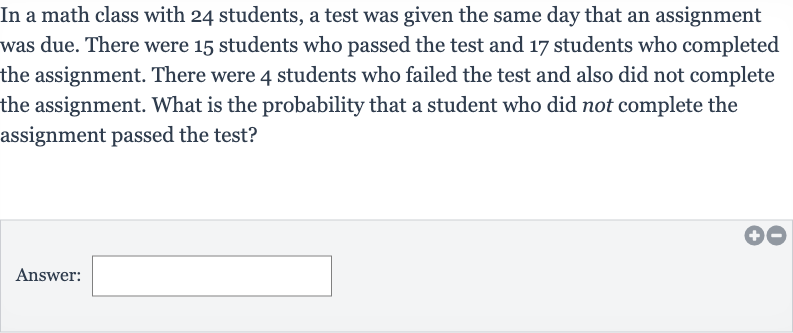AI tutor
Welcome to Bytelearn!
Let’s check out your problem:

In a math class with students, a test was given the same day that an assignment was due. There were students who passed the test and students who completed the assignment. There were students who failed the test and also did not complete the assignment. What is the probability that a student who did not complete the assignment passed the test?Answer:
Full solution
Q. In a math class with students, a test was given the same day that an assignment was due. There were students who passed the test and students who completed the assignment. There were students who failed the test and also did not complete the assignment. What is the probability that a student who did not complete the assignment passed the test?Answer:
- Determine Total Students Not Completed: Determine the total number of students who did not complete the assignment.Since there are students in total and students completed the assignment, the number of students who did not complete the assignment is .
- Students Passed Test Not Completed Assignment: Determine the number of students who passed the test but did not complete the assignment.We know that students failed the test and did not complete the assignment. Since there are students who passed the test, we need to find out how many of those who passed did not complete the assignment. We can calculate this by subtracting the number of students who both passed the test and completed the assignment from the total number of students who passed the test.
- Calculate Students Passed & Completed: Calculate the number of students who both passed the test and completed the assignment.Since there are students in total, students neither passed the test nor completed the assignment, and students did not complete the assignment, we can find the number of students who both passed the test and completed the assignment by subtracting those who did not complete the assignment and those who neither passed the test nor completed the assignment from the total number of students.So, the number of students who both passed the test and completed the assignment is .
- Calculate Students Passed Not Completed: Calculate the number of students who passed the test but did not complete the assignment.We know that students passed the test in total. From Step , we know that students both passed the test and completed the assignment. Therefore, the number of students who passed the test but did not complete the assignment is .
- Calculate Probability: Calculate the probability that a student who did not complete the assignment passed the test.From Step , we know there are students who did not complete the assignment. From Step , we know that of these students passed the test. Therefore, the probability that a student who did not complete the assignment passed the test is .
More problems from Probability of independent and dependent events
QuestionGet tutor help
QuestionGet tutor help
QuestionGet tutor help
QuestionGet tutor help
QuestionGet tutor help
QuestionGet tutor help
QuestionGet tutor help
QuestionGet tutor help
QuestionGet tutor help
